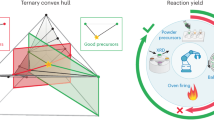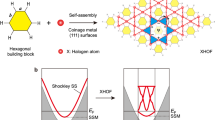Abstract
Morphological control of nanocrystals has become increasingly important, as many of their physical and chemical properties are highly shape dependent. Nanocrystal shape control for both single- and multiple-material systems, however, remains empirical and challenging. New methods need to be explored for the rational synthetic design of heterostructures with controlled morphology. Overgrowth of a different material on well-faceted seeds, for example, allows for the use of the defined seed morphology to control nucleation and growth of the secondary structure. Here, we have used highly faceted cubic Pt seeds to direct the epitaxial overgrowth of a secondary metal. We demonstrate this concept with lattice-matched Pd to produce conformal shape-controlled core–shell particles, and then extend it to lattice-mismatched Au to give anisotropic growth. Seeding with faceted nanocrystals may have significant potential towards the development of shape-controlled heterostructures with defined interfaces.
This is a preview of subscription content, access via your institution
Access options
Subscribe to this journal
Receive 12 print issues and online access
$259.00 per year
only $21.58 per issue
Buy this article
- Purchase on Springer Link
- Instant access to full article PDF
Prices may be subject to local taxes which are calculated during checkout




Similar content being viewed by others
References
Milliron, D. J. et al. Colloidal nanocrystal heterostructures with linear and branched topology. Nature 430, 190–195 (2004).
Kudera, S. et al. Selective growth of PbSe on one or both tips of colloidal semiconductor nanorods. Nano Lett. 5, 445–449 (2005).
Buonsanti, R. et al. Seeded growth of asymmetric binary nanocrystals made of a semiconductor TiO2 rodlike section and a magnetic γ-Fe2O3 spherical domain. J. Am. Chem. Soc. 128, 16953–16970 (2006).
Talapin, D. V. et al. Highly emissive colloidal CdSe/CdS heterostructures of mixed dimensionality. Nano Lett. 3, 1677–1681 (2003).
Kwon, K.-W. & Shim, M. γ-Fe2O3/II-VI sulfide nanocrystal heterojunctions. J. Am. Chem. Soc. 127, 10269–10275 (2005).
Kwon, K.-W., Lee, B. H. & Shim, M. Structural evolution in metal oxide/semiconductor colloidal nanocrystal heterostructures. Chem. Mater. 18, 6357–6363 (2006).
Teranishi, T., Inoue, Y., Nakaya, M., Oumi, Y. & Sano, T. Nanoacorns: Anisotropically phase-segregated CoPd sulfide nanoparticles. J. Am. Chem. Soc. 126, 9914–9915 (2004).
Mokari, T., Sztrum, C. G., Salant, A., Rabani, E. & Banin, U. Formation of asymmetric one-sided metal-tipped semiconductor nanocrystal dots and rods. Nature Mater. 4, 855–863 (2005).
Shi, W. et al. A general approach to binary and ternary hybrid nanocrystals. Nano Lett. 6, 875–881 (2006).
Yu, H. et al. Dumbbell-like bifunctional Au-Fe3O4 nanoparticles. Nano Lett. 5, 379–382 (2005).
Gu, H., Zheng, R., Zhang, X. & Xu, B. Facile one-pot synthesis of bifunctional heterodimers of nanoparticles: A conjugate of quantum dot and magnetic nanoparticles. J. Am. Chem. Soc. 126, 5664–5665 (2004).
Gu, H., Yang, Z., Gao, J., Chang, C. K. & Xu, B. Heterodimers of nanoparticles: Formation at a liquid-liquid interface and particle-specific surface modification by functional molecules. J. Am. Chem. Soc. 127, 34–35 (2005).
Yang, J., Elim, H. I., Zhang, Q., Lee, J. Y. & Ji, W. Rational synthesis, self-assembly, and optical properties of PbS-Au heterogeneous nanostructures via preferential deposition. J. Am. Chem. Soc. 128, 11921–11926 (2006).
Casavola, M. et al. Topologically controlled growth of magnetic-metal-functionalized semiconductor oxide nanorods. Nano Lett. 7, 1386–1395 (2007).
Pacholski, C., Kornowski, A. & Weller, H. Nanomaterials: Site-specific photodeposition of silver on ZnO nanorods. Angew. Chem. Int. Edn 43, 4774–4777 (2004).
Pellegrino, T. et al. Heterodimers based on CoPt3-Au nanocrystals with tunable domain size. J. Am. Chem. Soc. 128, 6690–6698 (2006).
Gao, X., Yu, L., MacCuspie, R. I. & Matsui, H. Controlled growth of Se nanoparticles on Ag nanoparticles in different ratios. Adv. Mater. 17, 426–429 (2005).
Xiang, Y. et al. Formation of rectangularly shaped Pd/Au bimetallic nanorods: Evidence for competing growth of the Pd shell between the {110} and {100} side facets of Au nanorods. Nano Lett. 6, 2290–2294 (2006).
Krichevski, O., Tirosh, E. & Markovich, G. Formation of gold-silver nanowires in thin surfactant solution films. Langmuir 22, 867–870 (2006).
Tsuji, M. et al. Crystal structures and growth mechanisms of Au@Ag core–shell nanoparticles prepared by the microwave-polyol method. Cryst. Growth Des. 6, 1801–1807 (2006).
Sanedrin, R. G., Georganopoulou, D. G., Park, S. & Mirkin, C. A. Seed-mediated growth of bimetallic prisms. Adv. Mater. 17, 1027–1031 (2005).
Kim, F., Connor, S., Song, H., Kuykendall, T. & Yang, P. Platonic gold nanocrystals. Angew. Chem. Int. Edn 43, 3673–3677 (2004).
Song, H., Kim, F., Connor, S., Somorjai, G. A. & Yang, P. Pt nanocrystals: Shape control and Langmuir-Blodgett monolayer formation. J. Phys. Chem. B 109, 188–193 (2005).
Tao, A., Sinsermsuksakul, P. & Yang, P. Polyhedral silver nanocrystals with distinct scattering signatures. Angew. Chem. Int. Edn 45, 4597–4601 (2006).
Chen, J., Herricks, T. & Xia, Y. Polyol synthesis of platinum nanostructures: Control of morphology through the manipulation of reduction kinetics. Angew. Chem. Int. Edn 44, 2589–2592 (2005).
Sau, T. K. & Murphy, C. J. Room temperature, high-yield synthesis of multiple shapes of gold nanoparticles in aqueous solution. J. Am. Chem. Soc. 126, 8648–8649 (2004).
Wiley, B., Sun, Y., Mayers, B. & Xia, Y. Shape-controlled synthesis of metal nanostructures: The case of silver. Chem. Eur. J. 11, 454–463 (2005).
Murphy, C. J. & Jana, N. R. Controlling the aspect ratio of inorganic nanorods and nanowires. Adv. Mater. 14, 80–82 (2002).
Gole, A. & Murphy, C. J. Seed-mediated synthesis of gold nanorods: Role of the size and nature of the seed. Chem. Mater. 16, 3633–3640 (2004).
Yong, K.-T. et al. Shape control of PbSe nanocrystals using noble metal seed particles. Nano Lett. 6, 709–714 (2006).
Sun, Y., Yin, Y., Mayers, B. T., Herricks, T. & Xia, Y. Uniform silver nanowires synthesis by reducing AgNO3 with ethylene glycol in the presence of seeds and poly(vinyl pyrrolidone). Chem. Mater. 14, 4736–4745 (2002).
Lee, H. et al. Morphological control of catalytically active platinum nanocrystals. Angew. Chem. Int. Edn 45, 7824–7828 (2006).
Banse, B. A. & Koel, B. E. Interaction of oxygen with palladium(111): High effective oxygen pressure conditions by using nitrogen dioxide. Surf. Sci. 232, 275–285 (1990).
Somorjai, G. A. Introduction to Surface Chemistry and Catalysis (Wiley, New York, 1994).
Veisz, B. & Kiraly, Z. Size-selective synthesis of cubooctahedral palladium particles mediated by metallomicelles. Langmuir 19, 4817–4824 (2003).
Pileni, M.-P. The role of soft colloidal templates in controlling the size and shape of inorganic nanocrystals. Nature Mater. 2, 145–150 (2003).
Johnson, C. J., Dujardin, E., Davis, S. A., Murphy, C. J. & Mann, S. Growth and form of gold nanorods prepared by seed-mediated, surfactant-directed synthesis. J. Mater. Chem. 12, 1765–1770 (2002).
Lamy, C. & Leger, J. M. Electrocatalytic oxidation of small organic molecules at platinum single crystals. J. Chim. Phys. 88, 1649–1671 (1991).
Markovic, N. M. & Ross, P. N. Surface science studies of model fuel cell electrocatalysts. Surf. Sci. Rep. 45, 117–229 (2002).
Baldauf, M. & Kolb, D. M. Formic acid oxidation on ultrathin Pd films on Au(hlk) and Pt(hkl) electrodes. J. Phys. Chem. 100, 11375–11381 (1996).
Hoshi, N., Kida, K., Nakamura, M., Nakada, M. & Osada, K. Structural effects of electrochemical oxidation of formic acid on single crystal electrodes of palladium. J. Phys. Chem. B 110, 12480–12484 (2006).
Niesz, K., Grass, M. & Somorjai, G. A. Precise control of the Pt nanoparticle size by seeded growth using EO13PO30EO13 triblock copolymers as protective agents. Nano Lett. 5, 2238–2240 (2005).
Acknowledgements
This work was supported by the US Department of Energy under Contract #DE-AC02-05CH11231. All TEM investigations, with the exception of those done on the Tecnai G2 S-Twin, were carried out at the National Center for Electron Microscopy, Lawrence Berkeley National Lab. We would also like to thank T. R. Kuykendall for the SEM work.
Author information
Authors and Affiliations
Corresponding author
Ethics declarations
Competing interests
The authors declare no competing financial interests.
Supplementary information
Supplementary Information
Supplementary figures S1-S4 (PDF 789 kb)
Rights and permissions
About this article
Cite this article
Habas, S., Lee, H., Radmilovic, V. et al. Shaping binary metal nanocrystals through epitaxial seeded growth. Nature Mater 6, 692–697 (2007). https://doi.org/10.1038/nmat1957
Received:
Accepted:
Published:
Issue Date:
DOI: https://doi.org/10.1038/nmat1957
This article is cited by
-
Shape-Controlled Synthesis of Platinum-Based Nanocrystals and Their Electrocatalytic Applications in Fuel Cells
Nano-Micro Letters (2023)
-
Modulating the alloying mode in the doping-induced synthesis of Au-Pd nanowires
Nano Research (2023)
-
Enhanced Performance of Bimetallic Pd-based Electrocatalysts for Formic Acid Oxidation
Topics in Catalysis (2023)
-
Epitaxial growth of highly symmetrical branched noble metal-semiconductor heterostructures with efficient plasmon-induced hot-electron transfer
Nature Communications (2023)
-
Surface lattice engineering for fine-tuned spatial configuration of nanocrystals
Nature Communications (2021)



